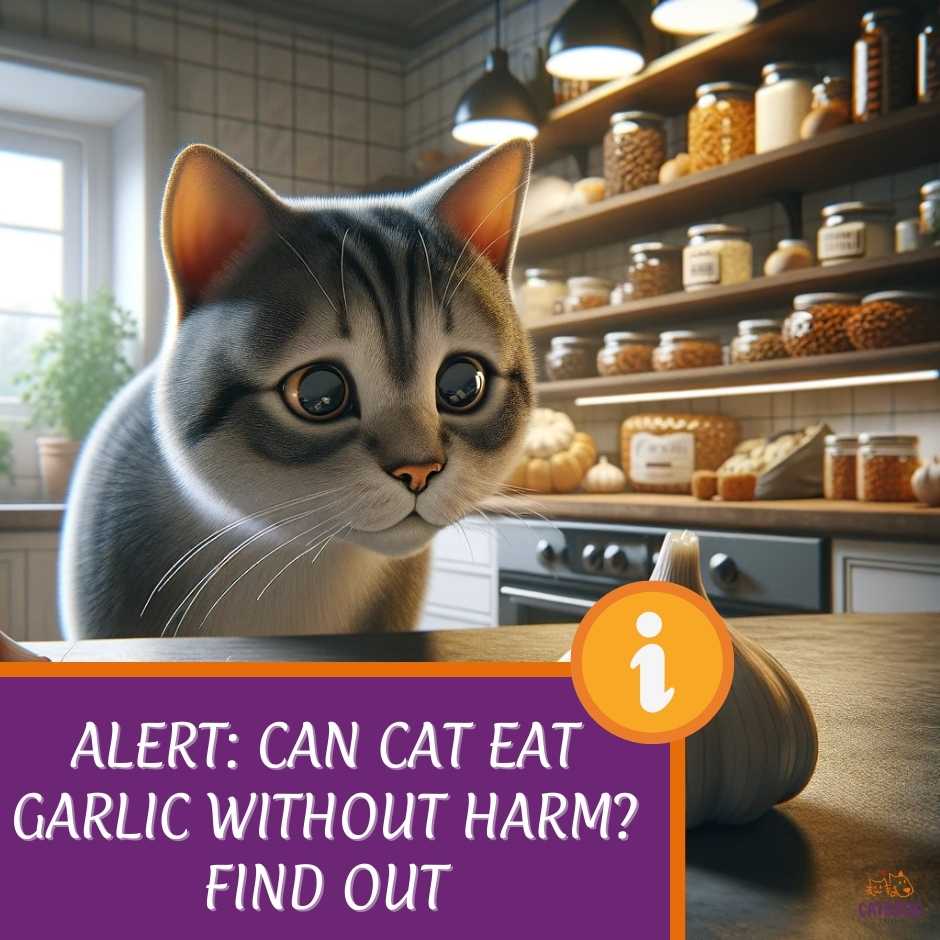Have you ever wondered if can cat eat garlic? No. It’s not safe and can lead to anemia.
It’s a common question that stirs up quite a debate among cat owners and experts.
While we humans enjoy garlic for its flavor and health benefits, it’s essential to consider whether what’s good for us is also safe for our cats.
Cats require a diet rich in proteins, fats, and vitamins to stay healthy, and understanding what foods are safe for them is crucial for their well-being.
Some human foods are fine as special treats for our favorite felines. But technically, cats don’t need human food at all as their wet and dry food is formulated to meet all their nutritional needs.
There are also many toxic human foods cat should avoid, but can cats eat garlic? Not—here’s how to protect your kitty from the toxic veggie. (1)
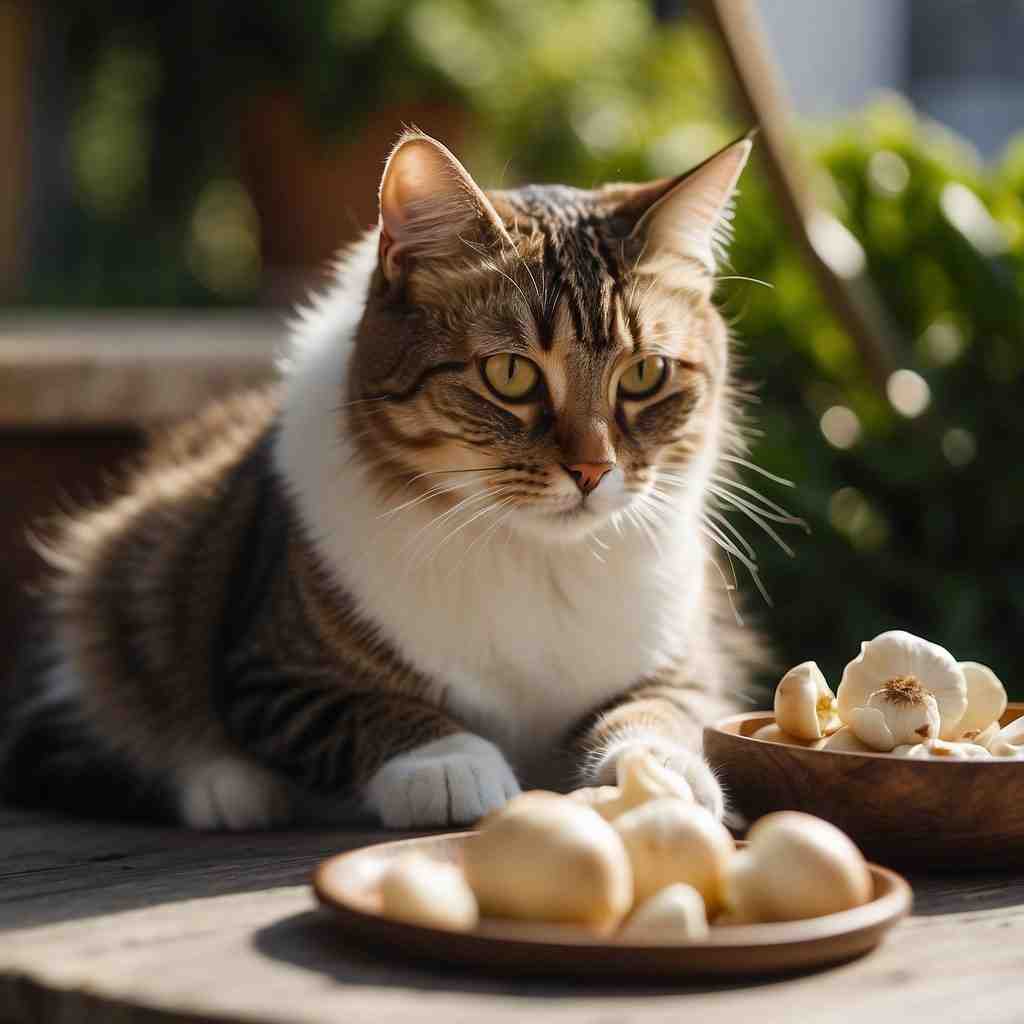
Garlic, as you may not know, falls into a category of foods that are contentious when it comes to feeding it to cats.
While you might think a tiny amount of fresh garlic could not harm, the reality is that garlic can be quite risky for our feline companions.
There’s growing evidence that even a small amount of garlic, like in garlic bread, could lead to health issues for cats due to their unique digestive systems.
Need to be careful feeding your cat sausage, cause sausage also contains garlic which is also quite harmful.
So before sharing your garlicky leftovers with your cat, it’s worth taking a closer look at what might be at stake, especially considering the potential effects of enough garlic on cats’ health.
Key Takeaways
- Cats have specific dietary needs and garlic is not safe for them.
- The risks associated with feeding garlic to cats include potential health issues.
- Cat owners should follow responsible feeding practices to ensure their pet’s safety.
The Risks of Garlic in a Cat’s Diet
Hey there, have you ever wondered about the effects of garlic on your fur baby? While it’s great for spicing up our spaghetti, it’s a big no-no for your cat’s dinner plate.
Garlic contains thiosulfate, and this compound is a no-go for your feline friend. It’s not just about bad breath; the effects of garlic can be seriously toxic to cats.
The primary toxic property in garlic is n-propyl disulfide, found in active form in all vegetables of the Allium spp family.
So, it’s important to keep your cat away from any food that contains vegetables of the Allium spp family, such as garlic spices.
Even a single garlic clove can be all it takes to result in serious illness in cats. It doesn’t matter if it’s fresh or cooked garlic, or garlic salt or powder—it’s all toxic to cats.
Let’s break it down: garlic leads to oxidative damage to your cat’s red blood cells. (2)
That’s like rust on a car but for your cat’s bloodstream. This kind of damage can have your kitty feeling all sorts of unwell with symptoms like:
- Lethargy – Just like you on a lazy Sunday, but less of a choice for them. (3)
- Vomiting – Not the hairball kind. (4)
- Diarrhea – This needs no explanation, right? (5)
Take, for example, a curious case where a cat nibbled on some garlic and ended up with garlic poisoning, resulting in clinical issues. This furball went from sprightly to sluggish in no time. But why?
That pesky thiosulfate wreaks havoc in their little bodies, leading to hemolytic anemia—a fancy term for when red blood cells start breaking down way faster than they should.
In this case, the garlic contains a toxic compound called sodium n-propyl thiosulfate, which can cause damage to the red blood cells.
This toxin can make the red blood cells fragile, leading to their breakdown and destruction, resulting in anemia and discoloration of urine.
The anemia can deprive the body’s organs of oxygen and, in severe cases, can even lead to organ failure and death.
If he consumes enough garlic to cause clinical issues, you might see a transient gastrointestinal upset with no serious clinical signs until days later, when the body’s compensatory mechanisms have been depleted and red blood cell changes have caused anemia,” Mize says.
The vet will begin by performing a series of tests, such as a complete blood count, urinalysis, and blood chemistry profile, to diagnose garlic poisoning in cats.
This often results in anemia, a possibly fatal illness if not treated in time. In severe cases, a blood transfusion may be necessary.
She adds that your cat’s vitals will be monitored throughout their stay, and the duration of treatment will depend on the severity of their illness.
Remember, when it comes to your cat’s diet, think of garlic as vampire-level bad news. It’s a foodie’s friend but a cat’s foe. Keep those garlicky goodies out of paws’ reach, and stick to the vet-approved treats instead!
Your whiskered companion will thank you for it — in purrs and affection, if not in words. If you intend to give your kitty a succulent morsel of salmon, make sure it is thoroughly cooked without any type of garlic.
Better yet, leave it completely unseasoned, and keep in mind that veterinarians recommend that treats make up no more than 10 percent of your cat’s daily diet.
Here’s another important point: Garlic isn’t the only aromatic culprit in the Allium family potentially toxic to cats. Mize caution pet parents to avoid chives, leeks, onions, scallions or green onions, shallots, and fleas.
Poisoning can occur from either a single exposure to large amounts of garlic or chronic smaller exposures over time, she says.
According to Genna Mize, DVM, a technical services veterinarian at Virbac, garlic not only causes gastrointestinal upset but also potentially alters red blood cells and interferes with their very important function of transporting oxygen in the body.
Keep in mind that you can’t induce vomiting in cats at home safely, so most of the time, an emergency vet visit is a must!
Responsible Feeding Practices for Cat Owners

Well, let’s chat about why Fido’s feast is a no-go for your purring pal. Cats are obligate carnivores, so their menu leans heavily towards meat.
But that doesn’t mean they can’t be foodies! Variety is the spice of life, after all.
When it comes to introducing new foods to your cat’s diet, imagine you’re a culinary guide on a delicious journey. Start with lean meats like cooked chicken or turkey. (6)
Easy on the stomach and full of protein — a real hit! Looking for a veggie option? Some cats might like a bit of steamed carrots or green beans.
But remember, veggies are more of a garnish in the grand buffet of cat dining. You’ll want to:
- Introduce new foods slowly. A tiny amount to start with will help avoid any tummy troubles.
- Mix new foods with their usual kibble to keep things familiar.
Finding a balance in your cat’s diet keeps them happy and healthy. Here’s your golden rule: steer clear of human food.
Our flavorsome favorites often contain ingredients that are harmful to cats. Stick to cat-specific chow and treats, which are formulated to meet their nutritional needs.
Good feeding practices are as much about what you serve as how you serve it. A transition to new food should be a gradual affair.
Always watch for any signs of digestive issues or allergies. If in doubt, your vet’s advice is worth its weight in catnip.
Here’s a glance at some safe food alternatives:
| Safe Protein | Safe Vegetables |
| Cooked Chicken | Steamed Carrots |
| Cooked Turkey | Steamed Green Beans |
| Cooked Fish (in moderation) | Pumpkin (in moderation) |
Catch that? Feeding them with a no-garlic food ingredient is pivotal. Regular check-ins with your vet can ensure your furry friend’s meal plan is as optimized as their nap schedule.
Remember, a little care goes a long way in keeping those nine lives long and prospering!
Understanding Can Cat Eat Garlic and Behavior & Dietary Preferences
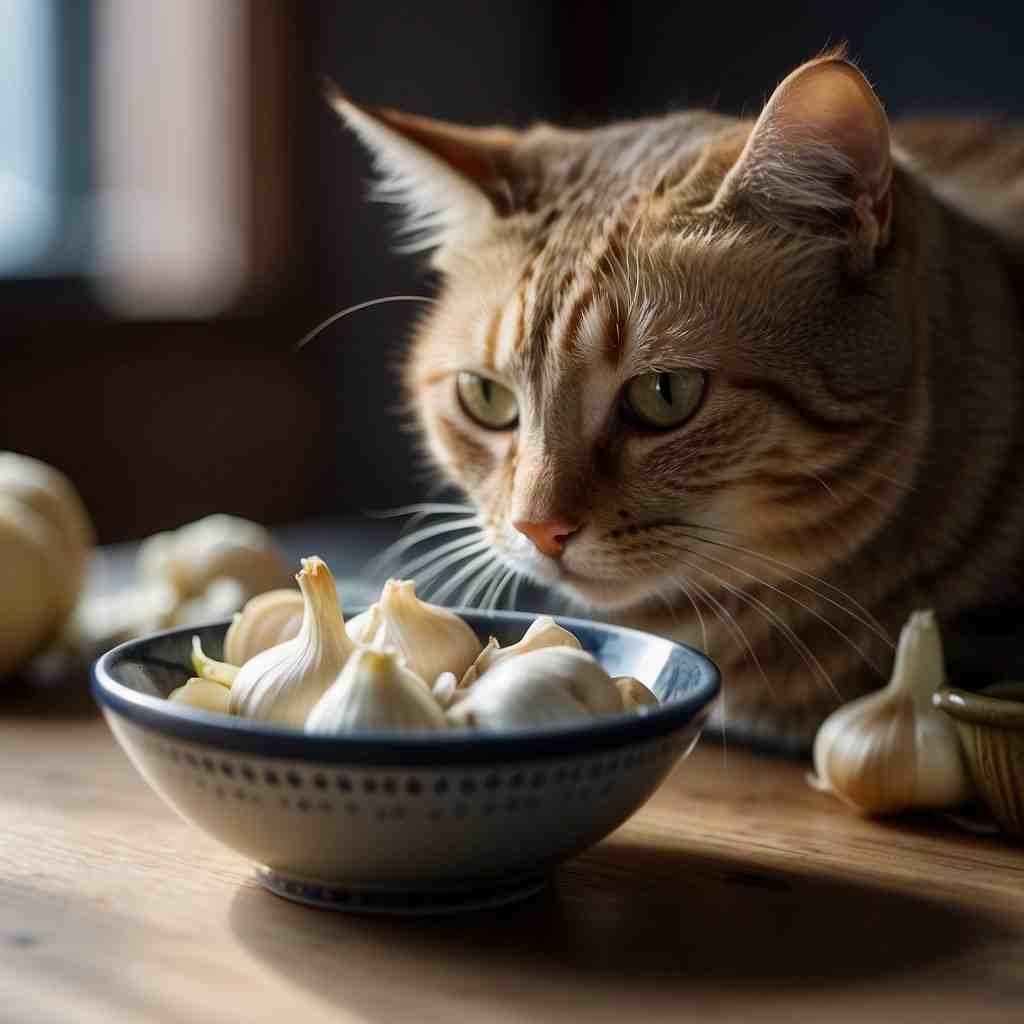
It’s all about their carnivorous nature—cats are natural hunters with a taste for meat, and it’s this instinct that guides their dietary preferences. Let’s dive in, shall we? (7)
First off, your cat’s behavior is a direct ticket to understanding what they should and shouldn’t eat.
Have you noticed they’re not exactly over the moon about your veggie platter? Well, cats are hardwired to crave meat, and they rely on it for essential nutrients.
Their digestive system is designed to process animal proteins, so plant-based items, such as the toxic veggie garlic, are generally a no-no.
Now, let’s talk about a cat’s environment. When you spice up their world with toys and activities, you’re catering to their inner predator, sharpening their hunting skills, and influencing their feeding behavior.
A well-enriched environment can mimic the variety and challenge of the great outdoors, and believe it or not, this can impact their eating habits too.
- Why do cats need such an enriched environment?
- Stimulates their natural hunting instincts
- Reduces stress and boredom-related overeating
- Encourages physical activity, aiding digestion
Remember, while you’re keen on enhancing their surroundings, keeping them away from harmful foods to cats, like garlic, is a big part of their care.
Garlic contains compounds toxic to cats, so it’s crucial to keep it out of paw’s reach.
Whether you’re whipping up a feast for yourself or pondering over the perfect cat diet, be mindful of these little carnivores’ needs.
After all, your mission is to keep them purring and healthy, right? So let’s leave the garlic to the spaghetti sauce and stick to what your sophisticated purr machine really craves: a protein-packed, garlic-free munch!
Advanced Insights into Cat Nutrition
Cats are obligate carnivores, which means their diet should be primarily composed of meat. Their unique biology requires certain amino acids and nutrients that they obtain from animal protein.
Anything outside of this can range from unnecessary to downright hazardous for their health.
Why can’t cats eat garlic?
- Thiosulfate Presence: Garlic contains a substance called thiosulfate, which is safe for humans but harmful to cats.
- Anemia Risk: This compound can cause oxidative damage to red blood cells, leading to anemia in cats—a condition where the blood doesn’t have enough healthy cells to transport oxygen efficiently.
Foods Cats Should Avoid:
- Allium Family: Garlic, onions, leeks, and chives.
- Dairy: Despite popular belief, most adult cats are lactose intolerant.
- Chocolate & Caffeine: Contain substances called methylxanthines, toxic to cats.
- Alcohol: Even small amounts can be dangerous.
- Grapes & Raisins: Known to cause kidney failure in cats.
Here are some scary tales from the fur side to give you pause: a cat owner once shared a slice of garlic toast, only to rush their pet to the emergency room with lethargy and pale gums—classic symptoms of anemia in felines.
In addition to steering clear of garlic and other Allium family members, responsible pet owners should prioritize avoiding toxic cake ingredients, ensuring that any homemade treats prepared for their feline friends are both safe and nutritious.
That’s one dinner date gone wrong!
Remember, it’s not just about what they eat, but also the balance of nutrients.
| Essential Nutrients | Benefits for Cats |
| Protein | Muscle & Tissue Repair |
| Taurine | Heart & Eye Health |
| Fatty Acids | Skin & Coat Condition |
So keep your cat’s diet lean and clean, and always consult with your vet before introducing new foods into their diet.
Your little prowler has specific dietary needs, and by meeting them, you’re not just filling their belly—you’re fueling their nine lives!
Additional Resources and Expert Guidance
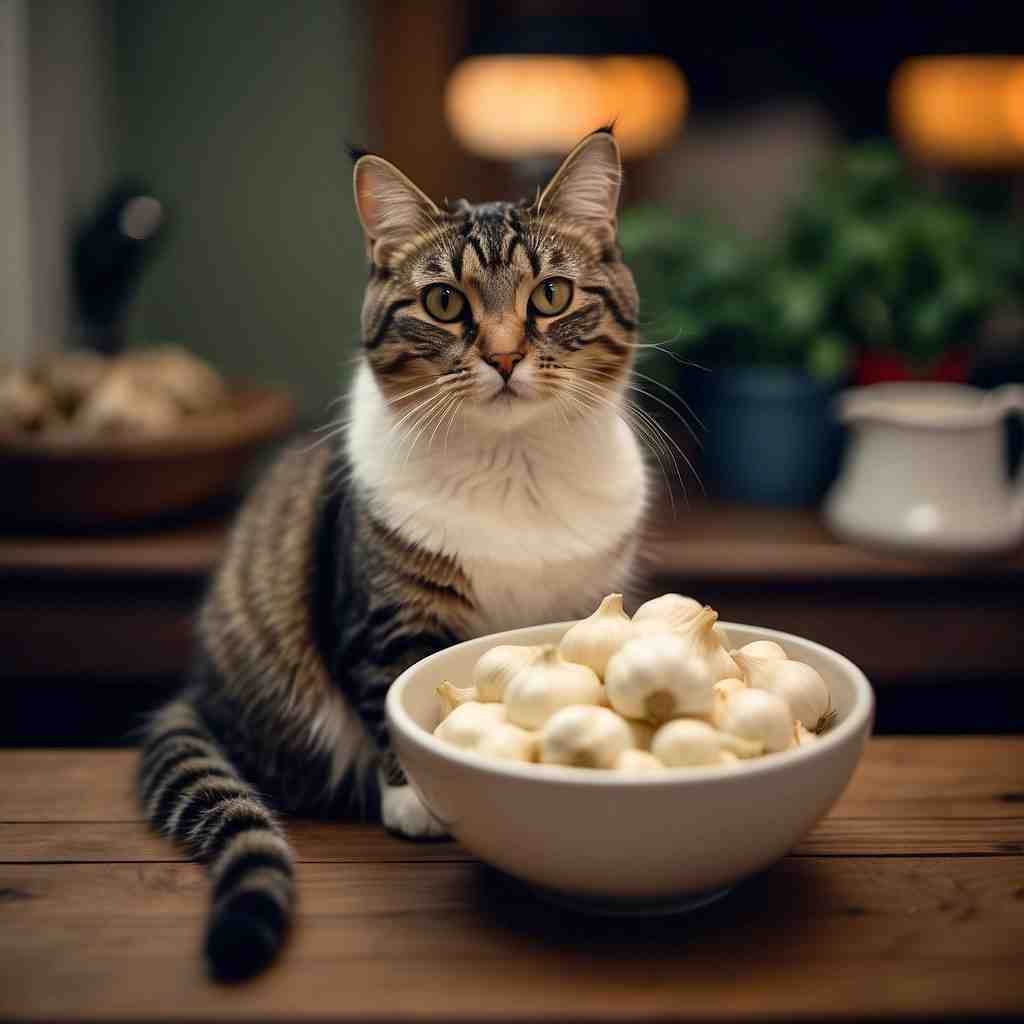
Seeking advice from your vet is a must – they’re like the cat-savvy friend who always knows best. Regular check-ups and diet consultations can keep Whiskers purring and healthy.
Can my kitty get essential nutrients from dry food? Your vet can provide expert guidance on the nutritional profile that fits your kitty’s daily needs, ensuring they receive all the essential nutrients they require.
It’s important to note that dry food is heavily processed and often contains a high amount of starch and grain, making it a high-calorie product.
Carbs in dry food can potentially cause gastrointestinal issues, diabetes, heart disease, hypertension, obesity, and dehydration. So, it’s crucial to consult with your vet to determine the best diet for your furry friend.
Books:
- The Cat: Clinical Medicine and Management by Susan Little DVM
- Cat Owner’s Home Veterinary Handbook by Debra M. Eldredge DVM
Remember these pointers:
- A sliver of garlic can wreak havoc on a kitty’s health.
- Multiple sources suggest as little as half a teaspoon of minced garlic could be hazardous.
- No matter the form—raw, cooked, powdered—keep garlic far from the cat bowl.
Keep your kitty’s nutrition on the right track with trusted info. You’ve got this, and your furball is counting on you!
(And, just between us, always remember that garlic is a no-go zone for your whiskered sidekick!)
Quick Recap
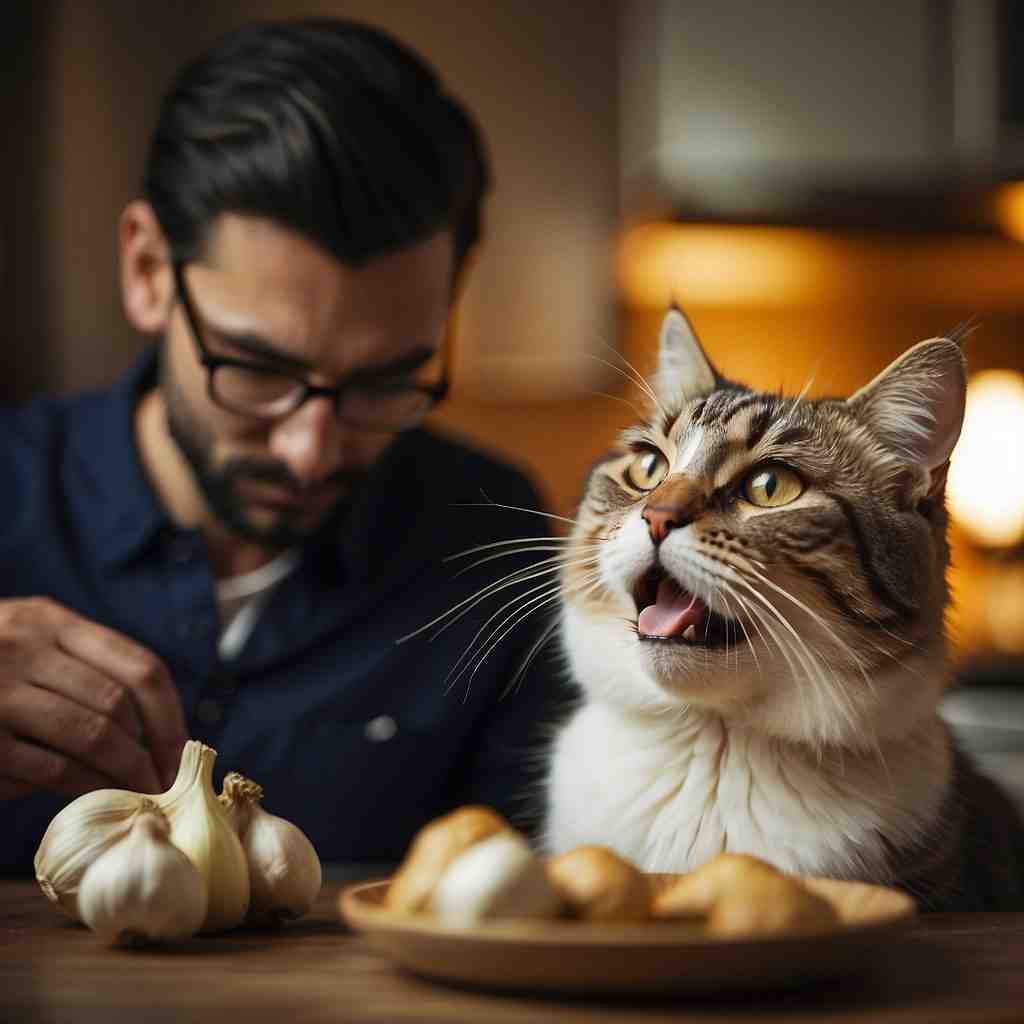
So, you’ve been wondering, can your furry friend nibble on a bit of garlic? Let’s break it down simply:
- Safety: Garlic is a no-go for cats. It’s not just a little oopsie but seriously harmful.
- Risks: Chowing down on this pungent bulb can lead to toxicity. Your cat might face symptoms like weakness, vomiting, or worse, organ damage.
Remember, cats and garlic are like oil and water—they don’t mix.
When thinking about your cat’s diet, the answer to garlic is a resounding no. It’s not safe and can lead to anemia. That’s not the kind of dinner date you want for your kitty!
Bottom line? Keep the garlic for your spaghetti and away from your whiskered companion.
Stick to vet-approved snacks and, of course, a cat bowl that keeps mealtime tidy and trouble-free. Isn’t that right? Now, let’s keep those nine lives as long and healthy as possible!
Frequently Asked Questions
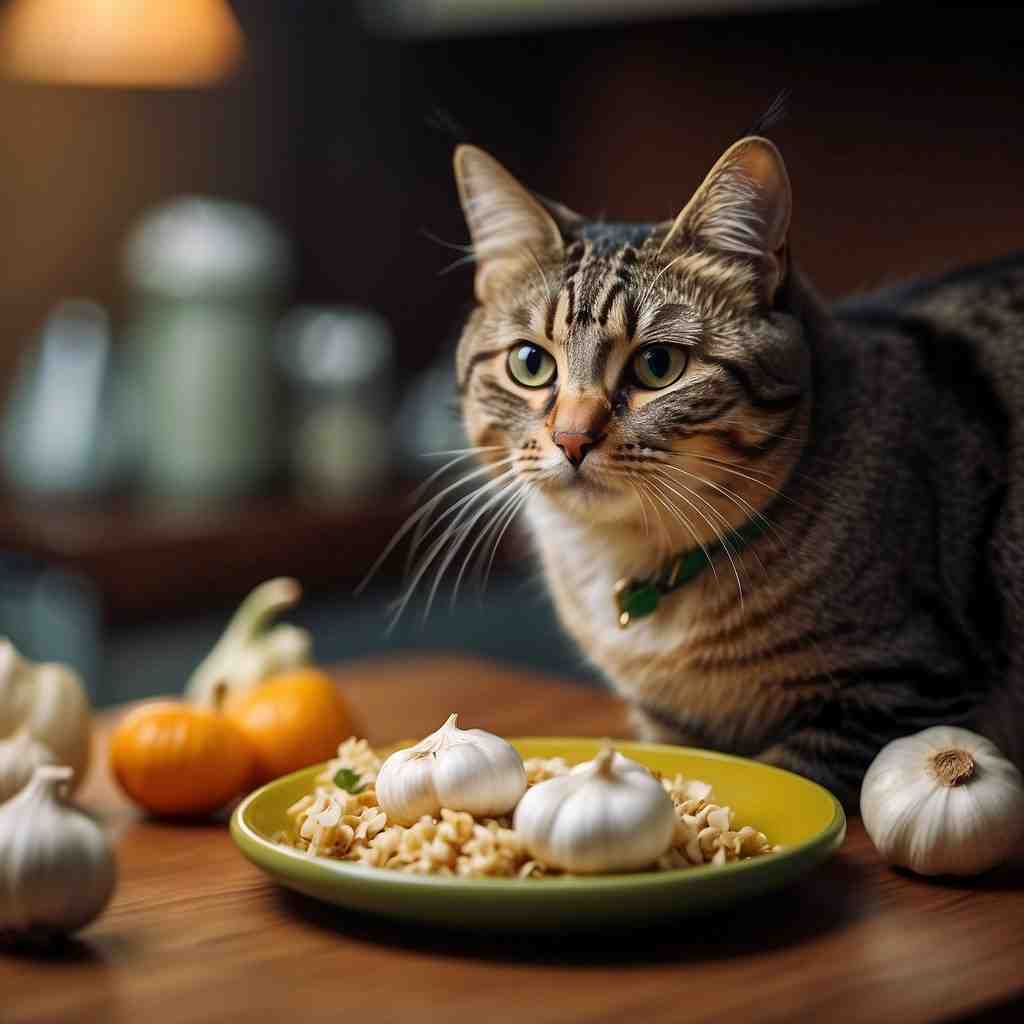
In this FAQ section, you’ll find must-know information if your cat has been exposed to garlic.
Whether it’s a little nibble or an accidental ingestion, understanding swift actions and recognizing symptoms can make all the difference.
What steps should I take if my cat has ingested garlic accidentally?
If you discover your cat has ingested garlic, contact your veterinarian or an animal poison control center immediately.
Time is crucial, and professional guidance is necessary to assess the risk and determine if your cat requires emergency care.
Could you elaborate on the potential symptoms indicating garlic toxicity in cats?
Sure! Keep an eye out for symptoms such as vomiting, diarrhea, lethargy, pale gums, rapid breathing, or a sudden decline in activity.
These signs usually surface within a few hours of ingestion but can be delayed, indicating possible garlic toxicity.
Is there a safe amount of garlic for cats, or should it be completely avoided?
There’s no safe amount of garlic for cats; it should always be completely avoided.
Garlic contains compounds like thiosulfate, which are toxic to felines, and even small amounts can lead to significant health issues.
How quickly can garlic affect a feline’s health, and what are the immediate actions to consider?
Garlic can impact your cat’s health rapidly, sometimes within just a few hours.
Immediate actions include contacting your vet and following their instructions, which may involve inducing vomiting or administering activated charcoal.
Is it harmful for cats to be around garlic during cooking, or is it solely an ingestion issue?
It’s primarily an ingestion issue, but strong odors can also be unpleasant to cats.
It’s best to keep your furry friend in a well-ventilated area away from strong scents during cooking to prevent any respiratory discomfort.

